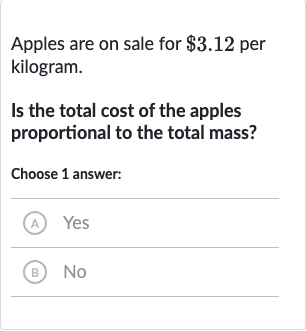Full solution
Q. Apples are on sale for per kilogram.Is the total cost of the apples proportional to the total mass?Choose answer:(A) Yes(B) No
- Understand definition of proportionality: To determine if the total cost is proportional to the total mass, we need to understand the definition of proportionality. Two quantities are proportional if they can be expressed as a constant ratio, meaning that as one quantity increases, the other increases at a constant rate.
- Cost per kilogram of apples: Given that apples are on sale for per kilogram, this means that for every kilogram of apples, the cost is . This is a constant rate, as the cost per kilogram does not change regardless of the total mass of apples purchased.
- Calculate total cost for different masses: If we were to buy kilograms of apples, the total cost would be . If we were to buy kilograms of apples, the total cost would be . In both cases, the cost is directly proportional to the mass, as it increases by the same rate of \$(\(3\).\(12\)) per kilogram.
- Conclusion: Since the cost per kilogram is constant and the total cost increases by this constant rate as the mass increases, we can conclude that the total cost of the apples is proportional to the total mass.
More problems from Is (x, y) a solution to the system of equations?
QuestionGet tutor help
QuestionGet tutor help

